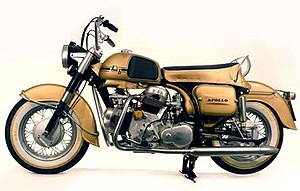Ducati Apollo
 |
|
| Manufacturer | Ducati |
|---|---|
| Production | 1964 (2 units) |
| Engine | 1,257 cc (76.7 cu in) air-cooled OHV 90° v-four |
| Wheelbase | 1,554.48 mm (61.200 in) |
| Dimensions |
W: Engine 450 mm (18 in) Handlebars 750 mm (30 in) |
| Seat height | 749.3 mm (29.50 in) |
| Weight | 270 kg (600 lb) (dry) |
The 1964 Ducati Berliner 1260 Apollo was a prototype 1,257 cc (76.7 cu in) V4 engine motorcycle producing 100 bhp (75 kW) and capable of over 120 mph (190 km/h). It was never put into production, but did influence other production Ducatis that followed. Both Ducati and their United States distributor, Berliner Motor Corporation, were experiencing declining sales of existing small-capacity single-cylinder models, and sought to create a bike to compete with Harley-Davidson. Berliner Motor was keen to have a model that could win lucrative police motorcycle supply contracts, and that could also sell as a civilian touring bike.
In 1959, the Berliner Motor Corporation approached Ducati about creating a rival to the Harley-Davidson to sell to police departments around the US. Author Greg Field, based on interviews with Mike Berliner, contends that Berliner went so far as to ship two Harley-Davidsons to Italy as examples (one was for Moto Guzzi), and that Ducati, rather than any Japanese company, was the first Harley-Davidson imitator.
The Berliner brothers were enthusiastic. Ducati's government management was not. It was only when Berliner agreed to underwrite a portion of the development costs in 1961, that the project went ahead. They decided to call it the Apollo, in honor of the moon mission series of the time.
Ducati was to produce two prototypes and two extra engines as spares. Today only one survives.
Fabio Taglioni was to develop a bike that conformed to US police specifications, and was bigger than any current model Harley-Davidson. Taglioni decided on an air-cooled 1257 cc 90° two-valve head V4 using a 180-degree crankshaft with roller bearing big ends. That crankshaft fitted into a horizontally split wet sump crankcase with a center main bearing support. The bore was 84.5 mm, and the stroke 56 mm. Valve actuation was by pushrods and rocker arms.
The engine was a stressed member of the heavy duty open cradle frame with a central box section front downtube between the forward cylinders. A small car-sized starter motor and generator were fitted. It had a five-speed transmission, at a time when most motorcycles had four. Ceriani developed the suspension package, but riders today would be alarmed by the inadequate front and rear single leading shoe 8.675 in (220.3 mm) drum brakes. The stopping distance was huge, and had to be allowed for. It had a 61.2 in (1,550 mm) wheelbase, and weighed 596 lb (270 kg) dry. Taglioni dismissed the Berliners' suggestion of shaft drive, and chose chain final drive. The police specification stipulated 16-inch tyres, so there was little choice in that.
...
Wikipedia
